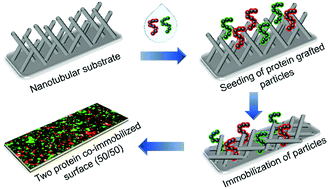Surface modification by assembling: a modular approach based on the match in nanostructures†
Abstract
Quantitative co-immobilization of multiple bioactive proteins or diverse chemical moieties on a surface is challenging because of the competition among the reactants. In this work, a two-step method is proposed, in which each type of reactant is firstly grafted onto the surface of functional nanoparticles, and then these nanoparticles are mixed and cast onto a substrate that has an appropriate nano-topography to trap and immobilize the nanoparticles. This approach has two distinct advantages: (1) it avoids competition among reactants of different natures; (2) the nanoparticles prepared in the first step can be physically mixed at the desired quantity and time and with the desired type. To demonstrate the feasibility, human and bovine albumins as model molecules were covalently immobilized onto the surface of reactive polypyrrole (PPy) nanoparticles, separately; and then the two types of protein grafted particles were mixed at various ratios in aqueous solution and cast onto the nanotubular surface of a PPy membrane. On drying, the nanotubes on the membrane surface shrunk and “locked” the particles, forming a stable bifunctional surface. Considering the availability of a wide range of nanoparticles and the technical capability to construct nanostructured substrates, this strategy may provide a general solution to quantitatively immobilize multiple biomolecules or chemical moieties. In particular, the electrically conductive and multi-biofunctional flexible PPy membrane demonstrated in this work can be a useful material platform for biomedical applications such as multi-target biosensing and targeted electrical stimulation.



 Please wait while we load your content...
Please wait while we load your content...